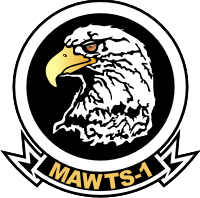By Robbin Laird
I had a chance to talk with LtCol Howard DeCastro, the first CO of MAWTS-1 and LtGen Barry Knutson, the eighth commander of MAWTS-1, the day before the change of command ceremony at MAWTS-1.
We talked about the approach of MAWTS-1 from the beginning and the importance of continuing the tradition and approach going forward for the USMC to operate effectively in today’s conflicts and combat situations.
DeCastro started with this comment: “We told people from the beginning, MAWTS does not fight wars.
“We are here to make people as good as they can be when they go to war.
“It is the squadron and the fleet marine force that is doing the work.
“At the beginning, some wanted MAWTS to have distinct uniforms and I said that was a bad idea.
“We are part of the force, but just focused on making them better.

“We are training the trainers who go to the squadrons and proliferate the best combat practices to the force.
“We are Marines.
“We are here to make the USMC better.
“Nothing less and nothing more.”
LtGen Knutson reinforced this point as follows: “Some brilliant people like Howard developed Project 19 and the idea of training the trainers. The trainers who come out of MAWTS are the training gurus of the squadron in the ops department to lead the training program and every squadron would have one or maybe two WTI graduates.
“Prior to MAWTS, training was divided between East Coast and West Coast Marines receiving different training. MAWTS-1 was established to have uniform training for the Marines.
“With MAWTS, we brought in the professionals, who knew what they were doing, and they were forged into an integrated force. It was from the beginning a center of excellence for training the trainers.
“The capability has only accelerated over the past thirty years. Now they are doing things we never even dreamed about doing and in all domains.
“The approach is to add on modules of new capabilities over time as the force has evolved. When I was here, I added a loadmaster course for the C-130, and we added a ground based air defense course for the Hawk and IR guys.
“Originally, we did not teach air-to-air tactics. To get a WTI patch, fighter pilots would go through Top Gun and MAWTS. But we could not get enough pilots through Top Gun to do so. To deal with that we added an air-to-air course after the WTI course so that the fighter pilots would work on their air-to-air tactics as well.”

This was the template created from the beginning at MAWTS-1 and because of the modular structure of training – adding modules to the training regime dependent on need and adding of capabilities – it is a template that has been able to grow into today’s variant of MAWTS-1 and also explains why there is clear continuity from its founding until today.
LtGen Knutson characterized MAWTS as “an operational petrie dish. We go out there and we put a FARP 60 miles out, we have F-35s overhead, we integrate all six functions of aviation, and we look at the logistics required.
“New technology gets inserted into a very, very complex and very realistic scenario, and Marines learn how to use any new gear. It’s like a crucible or like a petri dish. It’s a brilliant approach.”
Because of such a dynamic training template, a discussion with the first and eighth commanders of MAWTS-1 is very similar to the current COs of MAWTS which I then had two hours later on the MCAS Yuma base.


